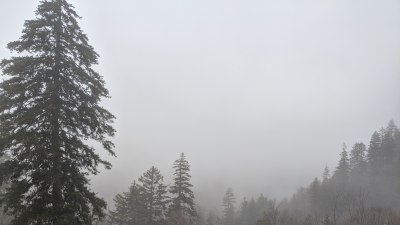Why You’re 10% More Spiritual When There’s Fog Outside
Explore the mystical connection between fog and spirituality in this intriguing article.

Fog has an uncanny ability to alter the landscape, absorbing sound and transforming familiar vistas into ethereal, dream-like scenes. Its gentle embrace adds an air of mystery to even the most mundane surroundings. Yet, beyond its aesthetic appeal, fog seems to evoke a spiritual response in many individuals. Studies and anecdotal evidence suggest that our sense of spirituality can be heightened on foggy days, and we may be 10% more inclined to connect with our inner selves and the universe around us. In this article, we explore the phenomena behind this intriguing observation, ranging from psychological factors to cultural interpretations and scientific insights.
First, let’s delve into the psychological impact of fog. When the sky is overcast and the air is thick with moisture, the world feels quieter and more introspective. The muffling effect of fog can create an atmosphere that encourages reflection. Our busy lives often bombard us with distractions, but fog can create a cocoon that allows us to focus inward. This internal space can help us to contemplate, meditate, and connect with our spiritual side.
Meditation and mindfulness practices suggest that an environment plays a significant role in one’s concentration and ability to achieve a spiritual state. Fog may induce a form of meditation simply by altering our perceptions of our surroundings. The dim lighting and reduced visibility compel us to slow down, observe, and tune into our thoughts and emotions. It becomes easier to detach from the hustle and bustle of life, promoting a feeling of tranquility that is conducive to spiritual exploration.
Furthermore, fog often stirs our imagination. The obscured horizon and transformed shapes of streetlamps, trees, and buildings can inspire awe and wonder. This sense of the unknown taps into our innate curiosity and could lead to profound realizations about life and our place within it. Research indicates that experiences of awe can foster a greater sense of connectedness to others and to nature, which are crucial elements of spiritual belief and practice.
Cultural Perspectives
Across various cultures, fog and mist have been associated with the mystical and the spiritual. In many historical contexts, fog has symbolized a veil between the ordinary and the divine. For example, in many mythologies, fog is depicted as a realm that separates humans from gods or spirits. This symbolism reinforces the idea that fog can enhance our spiritual experiences by creating a sense of stepping into another realm, even if only momentarily.
In some religious traditions, fog or mist is associated with enlightenment and divine presence. For instance, the Bible describes clouds and mist in representations of God’s presence, signifying mystery and unpredictability. In Buddhism, foggy mornings may symbolize the clear yet obscured path to enlightenment. The transient quality of fog serves as a reminder of change and impermanence—not unlike spiritual growth and awakening.
Nature and Spirituality
Connecting with nature is a well-known pathway to heightened spirituality, and foggy conditions can intensify this connection. Natural phenomena often remind us of our vulnerability and place within the greater cosmos. When fog blankets a landscape, it simplifies complex scenes into soft shapes and muted colors, allowing us to focus on the innate beauty of the world around us. Such experiences can evoke feelings of peace, gratitude, and wonder, all of which are integral to spiritual practices.
The interplay between fog and light is particularly captivating. The way fog scatters light can create a stunning visual experience, often leading to introspection and emotional responses that push us closer to spirituality. A foggy sunrise or sunset, for instance, can evoke a sense of magic, encouraging us to pause and appreciate the moment—a practice inherent in many spiritual disciplines.
Scientific Insights
The interplay between weather, mood, and spirituality has been studied in various psychological fields. Researchers have found evidence that weather conditions can influence human emotions and cognition. For instance, gray and cloudy days may lead to feelings of melancholy, while sunny days can uplift the spirit. Additionally, environmental psychology studies have shown that people are more inclined to meditate or practice self-reflection in serene natural settings, which fog can easily facilitate.
Moreover, the notion of “biophilia” relates to our biological tendency to connect with living things and nature. Foggy weather can amplify nature’s allure and inspire greater appreciation for our surroundings. This intrinsic connection can lead to spiritual experiences, as engaging with nature often fosters a sense of belonging and a deeper understanding of life’s mysteries.
Personal Experiences and Anecdotes
Many individuals report feeling more spiritually connected during foggy days, and their stories offer valuable insights into this phenomenon. Some describe using foggy mornings as a time for journaling, prayer, or meditation, finding that the ambiance enhances their practice and promotes clarity of thought. Others have shared experiences of walking in the fog, where the solitude and quietude allow for deep contemplation and connection with their inner selves.
Even informal gatherings, such as family walks in foggy conditions, can become spiritual experiences. Sharing moments of awe and reflection with loved ones can strengthen bonds and cultivate a shared sense of spirituality. These anecdotes reflect a universal theme: that fog serves as a catalyst for spiritual reflection and community connectivity.
Fog and Creativity
Fog has long been inspired artists, writers, and musicians. The mysterious ambience enhances creativity by encouraging a sense of the unknown. Many creatives find that fog stimulates their imaginations, urging them to explore profound themes such as existence, spirituality, and the human experience. Whether it’s in literature, painting, or music, fog provides a rich backdrop against which spiritual themes can be explored.
Visual artists frequently depict foggy landscapes as a way to capture the essence of the transient and elusive nature of life. In literature, characters may find enlightenment or divine inspiration during fog-laden journeys. Similarly, musicians may compose melodies that encapsulate the quiet solemnity of a fog-enshrouded world. This intersection of art and spirituality illustrates how fog can serve as a medium for exploring deeper existential themes.
In conclusion, the connection between fog and spirituality is a multidimensional exploration that encompasses psychological, cultural, and experiential domains. The calming presence of fog creates an environment ripe for self-reflection, awe, and creativity. As we embrace the atmosphere that fog brings, we may find ourselves leaning into moments of spiritual clarity. Whether through mindfulness, connection with nature, or creative expression, fog has an undeniable ability to enrich our spiritual journeys and deepen our connection with the world around us. So the next time you find yourself enveloped in fog, take a moment to pause and savor the stillness; you might just discover a surging connection to the spiritual realm.











